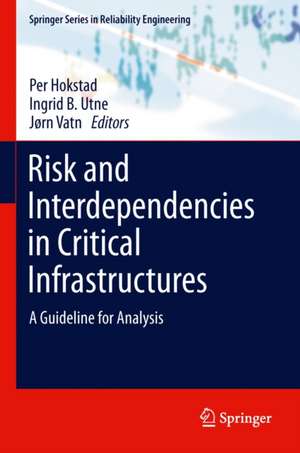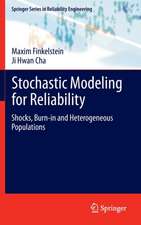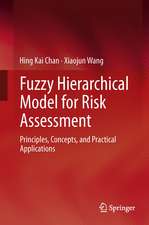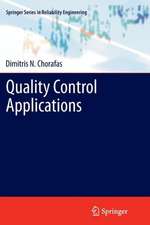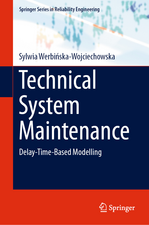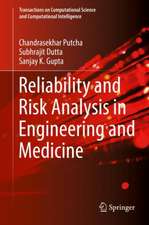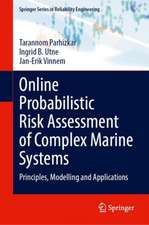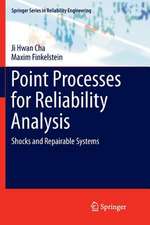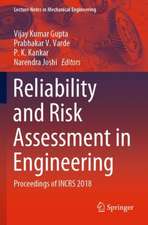Risk and Interdependencies in Critical Infrastructures: A Guideline for Analysis: Springer Series in Reliability Engineering
Editat de Per Hokstad, Ingrid B. Utne, Jørn Vatnen Limba Engleză Hardback – 17 dec 2012
A number of analysis approaches are described and are adapted to each of these infrastructures. Various approaches are also revised, and all are supported by several examples and illustrations. Particular emphasis is given to the analysis of various interdependencies that often exist between the infrastructures.
Risk and Interdependencies in Critical Infrastructures: A guideline for analysis provides a good tool to identify the hazards that are threatening your infrastructures, and will enhance the understanding on how these threats can propagate throughout the system and also affect other infrastructures, thereby identifying useful risk reducing measures. It is essential reading for municipalities and infrastructure owners that are obliged to know about and prepare for the risks and vulnerabilities of the critical infrastructures for which they are responsible.
| Toate formatele și edițiile | Preț | Express |
|---|---|---|
| Paperback (1) | 638.76 lei 6-8 săpt. | |
| SPRINGER LONDON – 28 ian 2015 | 638.76 lei 6-8 săpt. | |
| Hardback (1) | 643.34 lei 6-8 săpt. | |
| SPRINGER LONDON – 17 dec 2012 | 643.34 lei 6-8 săpt. |
Din seria Springer Series in Reliability Engineering
- 18%
 Preț: 1122.56 lei
Preț: 1122.56 lei - 20%
 Preț: 1277.89 lei
Preț: 1277.89 lei - 20%
 Preț: 987.32 lei
Preț: 987.32 lei - 18%
 Preț: 1406.66 lei
Preț: 1406.66 lei - 24%
 Preț: 1048.67 lei
Preț: 1048.67 lei - 20%
 Preț: 940.32 lei
Preț: 940.32 lei - 18%
 Preț: 952.09 lei
Preț: 952.09 lei -
 Preț: 313.32 lei
Preț: 313.32 lei - 18%
 Preț: 951.29 lei
Preț: 951.29 lei - 18%
 Preț: 947.02 lei
Preț: 947.02 lei - 15%
 Preț: 651.51 lei
Preț: 651.51 lei - 18%
 Preț: 1228.44 lei
Preț: 1228.44 lei - 18%
 Preț: 1227.67 lei
Preț: 1227.67 lei - 18%
 Preț: 952.89 lei
Preț: 952.89 lei - 18%
 Preț: 1234.94 lei
Preț: 1234.94 lei - 18%
 Preț: 1236.19 lei
Preț: 1236.19 lei - 18%
 Preț: 952.09 lei
Preț: 952.09 lei - 15%
 Preț: 635.65 lei
Preț: 635.65 lei - 20%
 Preț: 1274.57 lei
Preț: 1274.57 lei - 18%
 Preț: 1322.35 lei
Preț: 1322.35 lei - 15%
 Preț: 643.34 lei
Preț: 643.34 lei - 18%
 Preț: 1109.16 lei
Preț: 1109.16 lei - 15%
 Preț: 635.65 lei
Preț: 635.65 lei - 15%
 Preț: 654.62 lei
Preț: 654.62 lei - 18%
 Preț: 944.99 lei
Preț: 944.99 lei - 18%
 Preț: 953.65 lei
Preț: 953.65 lei - 18%
 Preț: 956.50 lei
Preț: 956.50 lei - 15%
 Preț: 644.95 lei
Preț: 644.95 lei - 18%
 Preț: 950.52 lei
Preț: 950.52 lei - 18%
 Preț: 1233.97 lei
Preț: 1233.97 lei - 15%
 Preț: 640.06 lei
Preț: 640.06 lei - 18%
 Preț: 956.69 lei
Preț: 956.69 lei - 18%
 Preț: 940.39 lei
Preț: 940.39 lei - 18%
 Preț: 948.92 lei
Preț: 948.92 lei -
 Preț: 389.70 lei
Preț: 389.70 lei - 18%
 Preț: 943.73 lei
Preț: 943.73 lei - 18%
 Preț: 1213.16 lei
Preț: 1213.16 lei - 18%
 Preț: 940.57 lei
Preț: 940.57 lei - 20%
 Preț: 985.03 lei
Preț: 985.03 lei - 18%
 Preț: 943.43 lei
Preț: 943.43 lei - 18%
 Preț: 1218.21 lei
Preț: 1218.21 lei - 18%
 Preț: 948.16 lei
Preț: 948.16 lei - 18%
 Preț: 948.92 lei
Preț: 948.92 lei - 18%
 Preț: 1727.24 lei
Preț: 1727.24 lei - 15%
 Preț: 638.43 lei
Preț: 638.43 lei
Preț: 643.34 lei
Preț vechi: 756.86 lei
-15% Nou
Puncte Express: 965
Preț estimativ în valută:
123.10€ • 128.87$ • 101.86£
123.10€ • 128.87$ • 101.86£
Carte tipărită la comandă
Livrare economică 05-19 aprilie
Preluare comenzi: 021 569.72.76
Specificații
ISBN-13: 9781447146605
ISBN-10: 1447146603
Pagini: 260
Ilustrații: VIII, 252 p.
Dimensiuni: 155 x 235 x 20 mm
Greutate: 0.5 kg
Ediția:2013
Editura: SPRINGER LONDON
Colecția Springer
Seria Springer Series in Reliability Engineering
Locul publicării:London, United Kingdom
ISBN-10: 1447146603
Pagini: 260
Ilustrații: VIII, 252 p.
Dimensiuni: 155 x 235 x 20 mm
Greutate: 0.5 kg
Ediția:2013
Editura: SPRINGER LONDON
Colecția Springer
Seria Springer Series in Reliability Engineering
Locul publicării:London, United Kingdom
Public țintă
ResearchCuprins
1.A brief overview of some methods and approaches for investigating interdependencies in critical infrastructures.- 2.Defining Concepts and Categorizing Interdependencies.- 3.Risk and Vulnerability Analysis of Critical Infrastructures.-4.Interdependency Modeling in Risk Analysis.- 5.Modelling, Simulation and Vulnerability Analysis of Interdependent Technical Infrastructures.- 6.Vulnerability Analyses of Interdependent Technical Infrastructures.- 7.Risk Analysis of Electricity Supply.- 8.Risk of Electricity Supply Interruptions.- 9.Integrated Urban Water System.- 10. Information and Communication Technology (ICT) – Enabling and Challenging Critical Infrastructure.- 11.Risk Based Design of Maritime Transport Systems.- 12.Risk of Supply Breaches in Maritime LNG Transport.- 13.Risk Management of Interconnected Infrastructures: An Empirical Study of Joint Stress Conditions.- 14.Organizational Challenges Regarding Risk Management in Critical Infrastructures.- Appendix A. Hierarchy of Hazardous Events.- Appendix B. Societal Critical Functions (SCF) and the Risk Analysis.- Appendix C. Risk Analysis Methods
Notă biografică
Per Hokstad is senior research scientist at SINTEF Safety Research, and has thorough experience in research and projects on reliability and risk analyses; e.g. in transportation, oil/gas and water supply. Until 1985 he was Assistant/Associate Professor at NTH in probability, statistics and reliability, and he was also Adjunct Professor in risk at NTNU 1990-2000.
Ingrid B. Utne is a Professor of marine operation and maintenance at Department of Marine Technology, NTNU. She has a PhD in safety and reliability, and she has worked on several research and industrial projects on risk analysis and maintenance management in shipping, oil/gas, and fisheries and aquaculture.
Jørn Vatn is a Professor in maintenance optimization at Department of Production and Quality Engineering, NTNU. He covers the field of risk analysis, reliability analysis and maintenance optimization. Application areas are transportation, offshore oil & gas, offshore wind energy and utility services.
Ingrid B. Utne is a Professor of marine operation and maintenance at Department of Marine Technology, NTNU. She has a PhD in safety and reliability, and she has worked on several research and industrial projects on risk analysis and maintenance management in shipping, oil/gas, and fisheries and aquaculture.
Jørn Vatn is a Professor in maintenance optimization at Department of Production and Quality Engineering, NTNU. He covers the field of risk analysis, reliability analysis and maintenance optimization. Application areas are transportation, offshore oil & gas, offshore wind energy and utility services.
Textul de pe ultima copertă
Today’s society is completely dependent on critical networks such as water supply, sewage, electricity, ICT and transportation. Risk and vulnerability analyses are needed to grasp the impact of threats and hazards. However, these become quite complex as there are strong interdependencies both within and between infrastructure systems. Risk and Interdependencies in Critical Infrastructures: A guideline for analysis provides methods for analyzing risks and interdependencies of critical infrastructures.
A number of analysis approaches are described and are adapted to each of these infrastructures. Various approaches are also revised, and all are supported by several examples and illustrations. Particular emphasis is given to the analysis of various interdependencies that often exist between the infrastructures.
Risk and Interdependencies in Critical Infrastructures: A guideline for analysis provides a good tool to identify the hazards that are threatening your infrastructures, and will enhance the understanding on how these threats can propagate throughout the system and also affect other infrastructures, thereby identifying useful risk reducing measures. It is essential reading for municipalities and infrastructure owners that are obliged to know about and prepare for the risks and vulnerabilities of the critical infrastructures for which they are responsible.
A number of analysis approaches are described and are adapted to each of these infrastructures. Various approaches are also revised, and all are supported by several examples and illustrations. Particular emphasis is given to the analysis of various interdependencies that often exist between the infrastructures.
Risk and Interdependencies in Critical Infrastructures: A guideline for analysis provides a good tool to identify the hazards that are threatening your infrastructures, and will enhance the understanding on how these threats can propagate throughout the system and also affect other infrastructures, thereby identifying useful risk reducing measures. It is essential reading for municipalities and infrastructure owners that are obliged to know about and prepare for the risks and vulnerabilities of the critical infrastructures for which they are responsible.
Caracteristici
Provides methods for analysng risks and interdependencies of critical infrastructures, such as water supply/sewage, elctricity, ICT and railway transportation Adapts various risk and vulnerability analysis techniques to each of these infrastructures Identifies useful risk reducing measures by enhancing the understanding on how hazards and threats can propagate throughout the system and also affect other infrastructures Includes supplementary material: sn.pub/extras
